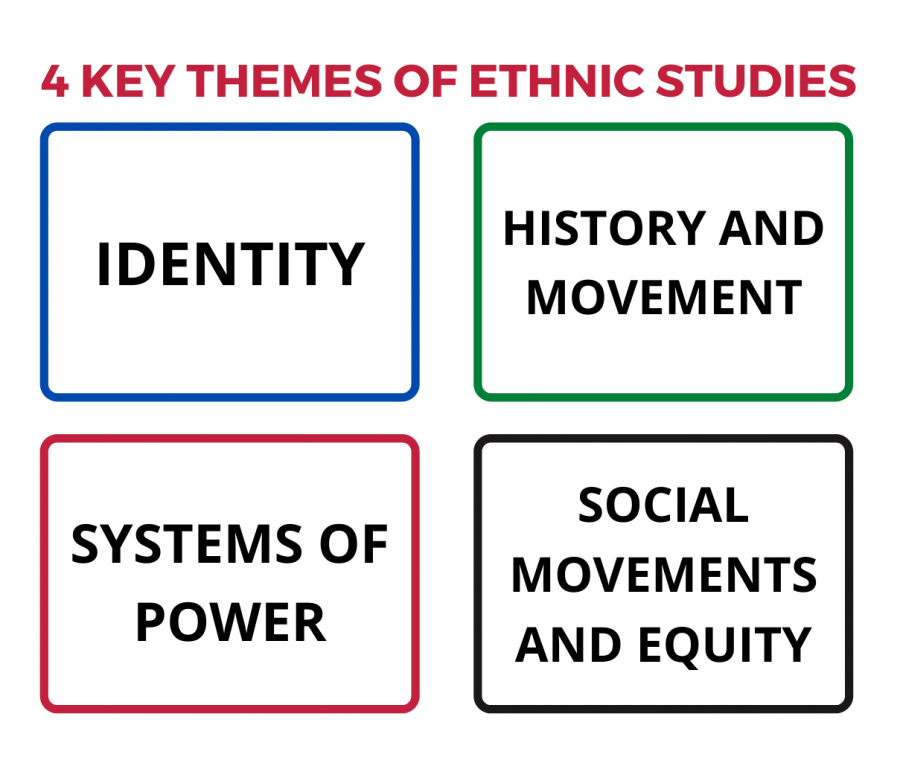Ethnic Studies is required beginning 2025-26 school year
How the recent California requirement should be implemented at MVHS
The 4 key themes of the Ethnic Studies curriculum are identity, history and movement, systems of power, and social movements and equity.
December 10, 2021
Gov. Gavin Newson signed a bill on Oct. 8, 2021 that requires all public high school students in California to take an Ethnic Studies course as part of their graduation requirements beginning with the graduating class of 2030, and must offer the course as an option starting in the 2025-26 school year. This added course will teach students about the struggles of different ethnic groups that are often left out of the typical U.S. History classes, including lessons on the Black Lives Matter movement, Asian-American discrimination and other injustices encountered by ethnic groups in the U.S.
Although the newly implemented requirement is not in effect yet, MVHS has already designed opportunities to educate students on the struggles of ethnic communities, like some of the weekly Advisory lessons during remote learning or the curriculum in certain literature classes like Honors American Literature or Contemporary Literature. However, these initiatives are only effective if students choose to be educated.
Students often use Advisory lessons as an opportunity to complete unfinished homework or go on their phones. This was especially true during remote learning, as most teachers would not require cameras to be on or for students to actively participate. Additionally, in regards to the literature classes such as Contemporary Literature and Writing that include units like Critical Race Theory, students are able to choose whether they want to take this class or not, resulting in some students not acquiring the same knowledge on the struggles of ethnic groups that their peers may have.
Being taught about these topics isn’t currently enforced, which only further proves why the newly signed bill is so important. It provides an opportunity to make students even more aware of the struggles of marginalized groups around them, and a required course ensures that every student gets to obtain this information. It introduces social inequities that still exist in our communities, and can motivate us to take action against them. But with this new requirement comes an obstacle — how do we integrate this course into our high school curriculum without severely impacting students’ schedules?
A solution would be to incorporate the Ethnic Studies curriculum into already existing literature classes offered on campus, much like we do with the Health curriculum being taught in Freshman Physical Education and Biology courses. Though Ethnic Studies curriculum may be seen as more suitable for a history class with its emphasis on the past experiences of ethnic groups, literature teachers of classes such as HAmLit or Contemporary Lit have already been teaching these concepts, so the idea of incorporating ethnic studies into English classes isn’t out of the question. Making this course a history class would also likely mean that students would take it as freshmen, since students don’t currently take a history class freshman year. However, this would cause the involvement in Art, Java, Woodshop, World Language, Writing for Publication and other elective courses to decrease as there would not be space left in the students’ schedules.
As high schools in the Bay Area begin to involve Ethnic Studies into their course offerings, they are actively trying to figure out the best way to execute its implementation. At Saratoga High School, freshmen will now be given the choice to take the new Ethnic Studies class or World Geography for a semester. Those who take the course will learn to address injustices regarding racism, privilege and the efforts of ethnic communities. However, this again excludes those who decide not to take the course, diminishing the purpose of the new law.
To fulfill the requirement of the bill, we should immerse Ethnic Studies curriculum into sophomore and junior year literature classes in order to ensure that all students get the chance to understand the struggles that ethnic groups in their society face, and so that we can educate them further on the contributions of different ethnic groups. Doing so can mitigate the decline of involvement in other electives, and strives to include all students on campus in the teaching of Ethnic Studies in hopes of promoting social change.




























